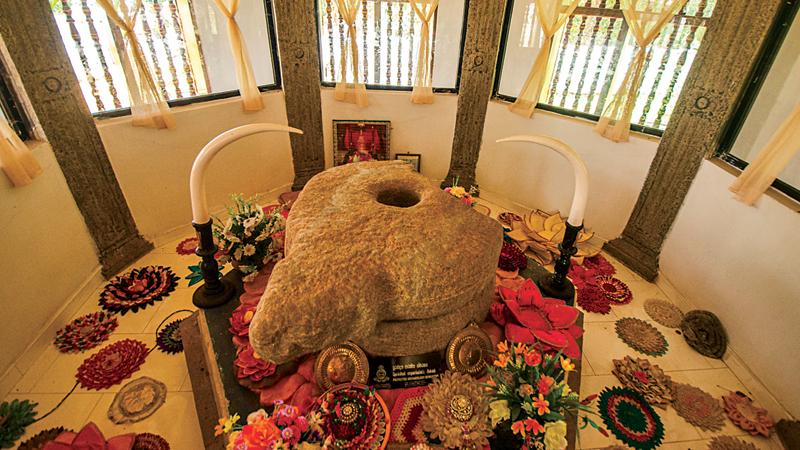
One of the grand cultural festivals of the island, the annual Esala Perahera of Senkadagala commences in August. On the eve of this pageant, we revisited the historic Sri Dalada Delgamuwa Vihara nestling in the serene, sleepy village of Delgamuwa off Kuruwita in Ratnapura to reminisce its glorious past. This less known temple has a special place in the annals of history in Sri Lanka as it provided protection to the sacred Tooth Relic of the Buddha for over 43 years.
Anyone who enters the temple premises wouldn’t see the historic importance of the place until one steps into the interior of the upper platform. There we had a commanding view of the whole of the Delgamuwa village dotted with rice fields, while the awe-inspiring mountain range of Sri Pada appeared in the distance interlaced with lush jungle vegetation.
Historic Bo tree
The temple had ancient stone walls in all four directions giving it a majestic appearance. A stone staircase leads to its summit which shelters a huge Bo tree with its sprawling branches, said to be over 800 years old. The tree offers shade to the sanctified ground, flanked by a dagaba and Buduge (image house), and its entrance is adorned by a striking mural of the sacred Tooth Relic in pristine white.
The centre of attraction of the temple is the much-revered massive Kurakkan grinding stone. Today, it remains sanctified, protected and revered, enclosed in an especially built cubicle in the upper platform of the temple ground. One side of the grinding stone is jarred, possibly damaged during the Portuguese raids.
 A painting depicting Ven. Mahindalankara Thera and Hiripitiye Diyawadana Nilame hiding the sacred Tooth Relic in the grinding stone |
Stepping into the Buduge, our second stop, I was enthralled to see the paintings relating to Buddhism and the journey of the sacred Tooth Relic in Sri Lanka. Almost all five paintings on the murals depict stories related to the sacred Tooth Relic in multi-coloured designs of lotus flowers.
Walking inside the shrine room, we discovered the exciting story of the sacred Tooth Relic vividly illustrated on the walls of the shrine room. The daring figures of King Mayadunne, King Rajasinha I, Ven. Mahindalankara Thera and Hiripitiye Disawa adorned the walls of the shrine room.
Nestling in between these religious buildings, we found an octagonal shaped building that housed a museum. The ancient remnants of tools, books, pottery and Buddha statues found in the temple ground are preserved in glass pane cupboards in this museum.
King Mayadunne
According to temple chronicles, its ancient construction work is attributed to King Mayadunne of Sitawaka (1521-1581). The Portuguese’ attempts to spread Christianity resulted in the baptism of Prince Dharmapala, the grandson of King Buwanekabahu VII of Kotte and heir to the throne.
Since the sacred relic was the supreme sign of leadership in the island, at this time, having seen a dream, the lay custodian of the Relic, Hiripitiye Diyawadana Nilame secretly brought the sacred Tooth Relic to King Mayadune of Sitawaka crossing the Kelani Ganga.
Perceiving the unsafe situation of his kingdom of Sitawaka due to the impending power of the Portuguese, the sacred Tooth Relic was kept hidden inside an unmovable grinding stone in a gold casket behind the Buddha statue for veneration in the newly built Delgamuwa Vihara, built by the king himself.
The grinding stone was selected to hide the sacred Tooth Relic since every household during that era owned a grinding stone to make Kurakkan flour. Hence, it was assumed that having a grinding stone in the temple premises would not cause suspicion. Thus the sacred Tooth Relic remained undiscovered for 43 years despite many search operations conducted by the Portuguese.
After the death of King Mayadunne, his son Rajasingha I of Sitawaka (1581-1593) became king and the Delgamuwa temple fell under his protection.
Esala Perahera
He was credited with initiating the Esala Perahera with the patronage of scholar bhikkhu and chief incumbent of Delagamuwa Vihara, Ven. Mahindalankara Thera. The sacred Tooth Relic was brought from the Delgamuwa Vihara to the Saparagamuwa Maha Saman Vihara, where the Ven. Thera is said to have held the Perahera for 11 years during his reign.
Since the coronation of Don Juan Dharmapala of Kotte (1551) to Wimaladharmasuriya I (1593) of Kandy, a period of nearly 42 years, the sacred Tooth Relic was concealed in the Delgamuwa Vihara. Realising the imminent invasion of Sabaragamuwa by the Portuguese after the death of King Rajasingha I of Sitawaka, King Wimaladharmasuriya I (1593-1604) had taken the sacred Tooth Relic in a grand procession to Kandy. It was then kept in a golden casket in a specially built two-storied mansion close to his palace in Senkadagala for veneration.
Grinding stone
Eventually, after the demise of King Rajasingha I, the Portuguese ransacked the Delgamuwa Vihara and robbed the temple of its treasures and built a fortress over the demolished temple. The temple was rebuilt during the 17th century and has lost its ancient grandeur but in it kept its most proud possession, an unmovable grinding stone and ancient stone flower altar with a faded motif of the lotus flower.
The chief incumbent of this temple, scholar bhikkhu,Ven. Mahalle Vipulatissa Thera has renovated the temple to its present condition, and also protected the grinding stone which is of historical value.
It is a place to be proud of, although it has not received much attention. However, if you happen to travel on the A4 highway along the Colombo-Ratnapura road turn right just before Kuruwita town and drive down 500 metres on a narrow road, and you would step into this historic temple. If you are a history buff, it is a must place to visit.

